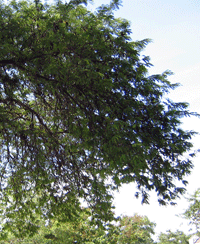
Akasia | Angsana | Asam Jawa | Jambu Laut | Jemerlang | Ketapang | Mambu | Mempari | Pukul Lima | Sentang

INTRODUCTION
A frost-tender, tropical, evergreen tree, Tamarind
is densely foliated with pale green, compound,
feathery leaflets which give the broad, spreading
crown a light, airy effect (Fig. 1). Tamarind may
reach heights of 65 feet and a spread of 50 feet but is
more often seen smaller. The delicate leaflets cast a
diffuse, dappled shade which will allow enough
sunlight to penetrate for a lawn to thrive beneath this
upright, dome-shaped tree.
GENERAL INFORMATION
Scientific name: Tamarindus indica
Pronunciation: tam-uh-RIN-dus IN-dih-kuh
Common name(s): Tamarind
Family: Leguminosae
USDA hardiness zones: 10 through 11 (Fig. 2)
Origin: not native to North America
Uses: large parking lot islands (> 200 square feet in
size); wide tree lawns (>6 feet wide); recommended
for buffer strips around parking lots or for median strip
plantings in the highway; shade tree; specimen;
residential street tree; no proven urban tolerance
Availability: grown in small quantities by a small
number of nurseries
Flower
Flower color: red; yellow
Flower characteristics: inconspicuous and not
showy; spring flowering
Fruit
Fruit shape: elongated; pod
Fruit length: 3 to 6 inches
Fruit covering: dry or hard
Fruit color: brown
Fruit characteristics: does not attract wildlife; suited
for human consumption; fruit, twigs, or foliage cause
significant litter; persistent on the tree; showy
USE AND MANAGEMENT
The twigs and branches of Tamarind are very
resistant to wind, making it especially useful as a
shade or street tree for breezy locations. But
Tamarind has low salt-tolerance so do not locate it
close to the beach. In spring, small red and yellow
flowers appear on short racemes and are followed by
the production of brittle, brown, six-inch-long, velvety
pods. These sticky pods are filled with a sweet-sour,
dark brown paste which surrounds two or three seeds.
They normally dry up and do not become messy but
some people will undoubtedly object to the fruit
falling on sidewalks or streets. Tamarind is grown
commercially in the tropics for production of this
edible paste, which is used as an ingredient for
Worcestershire sauce, soft drinks, hutneys, and
curries.
